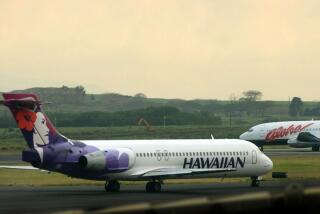Expansion Turns American Into a Major International Airline
- Share via
American Airlines’ purchase of rival Eastern Airlines’ South and Central American routes Tuesday capped a year-end buying binge intended to push American--the country’s largest domestic airline--to international prominence as well.
The shopping spree started Monday, when American snapped up money-losing Trans World Airlines’ valuable route to London from Chicago--a moneymaker that American has coveted for years. Then American snatched ailing Eastern’s routes in South America, making American a major force on that continent.
The two purchases ended a year of rapid expansion for American, which earlier added seven destinations in Europe, Australia and New Zealand to its roster. It now flies to seven countries in Europe, where it has focused much of its attention--up from none six years ago.
American is not the only U.S. airline spreading its wings around the globe. Its chief rivals, United Airlines and Delta Air Lines, have staked out destinations in Europe and Asia in bold attempts to grow.
Earlier this year, United, a strong transpacific carrier, announced a major expansion into Europe, where it did not fly a year ago. And Delta, besides building up its own flight schedule, engaged in stock swaps with Singapore Airlines and Swissair to strengthen its position overseas.
The moves into foreign markets not only help the giant U.S. airlines grow but help guard their lucrative home turf from foreign airlines that are making headway in the United States. For example, American’s main competitor on its new Chicago-to-London route is British Airways, which is the third-largest transatlantic carrier and controls 13.9% of that market. American has controlled 6.6%, ranking sixth.
James Carey, a vice president at Airline Economics, a Washington consulting firm, said the TWA deal should make American the fifth-largest transatlantic carrier, tied with KLM Royal Dutch Airlines. Pan American World Airways is the largest transatlantic airline, he said, followed by Trans World Airlines.
Airline industry analysts say consumers should benefit from airline expansion moves. “It increases competition, and to that extent, the consumer is the winner,” said Rose Ann Tortora, an analyst with the investment banking firm of Drexel Burnham Lambert in New York.
These analysts said the South American acquisition was a smart buy for American, already the leading U.S. carrier in the Caribbean region. To build its own route system, American would have had to obtain government approvals from each country--a tedious process that can take years.
Many South American countries are not receptive to new carriers. In fact, American was blocked from starting service to Costa Rica last week, even though government approval had been obtained. “We had 6,000 reservations for flights, and suddenly we could not fly there,” Mary O’Neil, an American spokeswoman, said.
Even with the necessary approvals, it would have been difficult for American to make money with flights to just a handful of South American destinations because few countries have much U.S.-bound traffic.
“The key to making money in South America is to have a network, so you can fly from country to country and pick up passengers as you go along,” said Ray Neidl, an airline analyst with the investment firm of Dillon, Read & Co. in New York.
American plans to use its new 15-country South and Central American network to strengthen its hubs in Miami and San Juan, Puerto Rico. American spokeswoman O’Neil said the airline envisions routing South America-bound passengers from Europe through Miami or San Juan.
“Strategically, it makes a lot of sense,” Drexel’s Tortora said.
Along with the South American routes, American also received from cash-strapped Eastern a route from Miami to Madrid, and two from Florida to Canada, further strengthening its foreign operations. And as settlement for a suit with Eastern’s sister company, Continental Airlines, American received a Continental route from Miami to London. The settlement was part of the South American sale package.
The deals show how American has taken advantage of Eastern’s weakened condition. A year ago, a full-blown American hub at Miami existed only on paper. But when Eastern’s machinists, pilots and flight attendants went on strike in March, American threw its resources into Miami, Eastern’s hub and headquarters city. Eastern is now in bankruptcy proceedings, trying to reorganize as a smaller airline.
Still, analysts said the $471 million that American agreed to pay Eastern for the routes was not a fire-sale price. “It’s a good, fair price,” analyst Neidl said.
More to Read
Inside the business of entertainment
The Wide Shot brings you news, analysis and insights on everything from streaming wars to production — and what it all means for the future.
You may occasionally receive promotional content from the Los Angeles Times.










